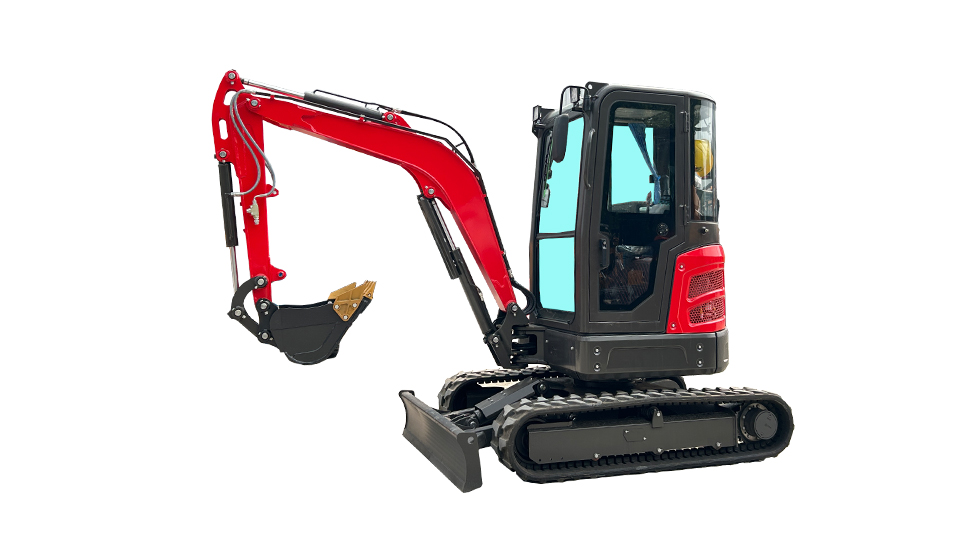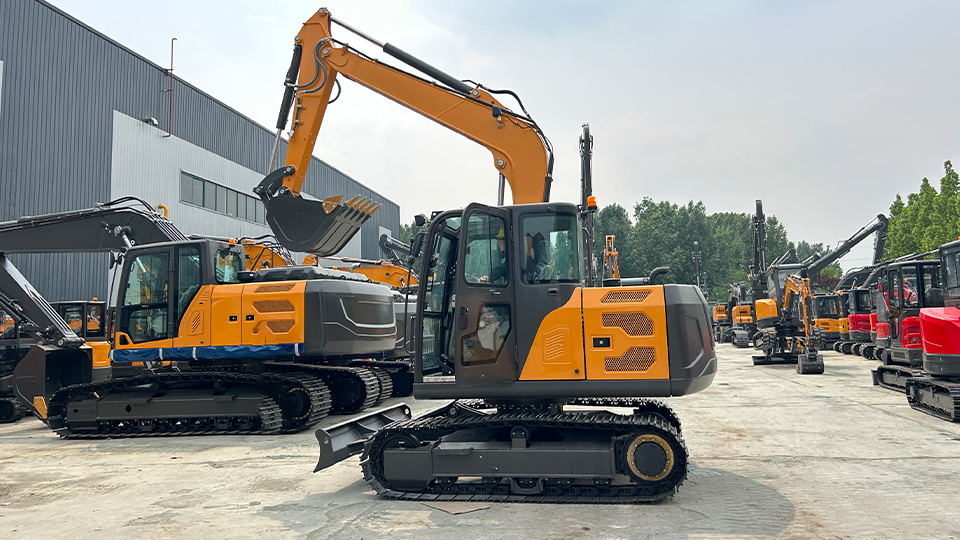I. Understanding the Risks: Common Accident Categories
Before diving into prevention, it's essential to recognize the primary categories of excavator accidents.
Rollovers/Tip-overs: This is one of the most dangerous and frequently fatal types of excavator accidents. It occurs when the machine's center of gravity shifts outside its stable base, often due to operating on slopes, uneven ground, overloading, or sudden movements.
Contact with Underground Utilities: Striking buried gas lines, electrical cables, water pipes, or communication lines can lead to explosions, electrocution, service disruptions, and severe environmental damage.
Contact with Overhead Power Lines: Similar to underground utilities, contact with live overhead electrical wires can result in electrocution, severe burns, or explosions.
Struck-by Accidents: This category includes accidents where ground personnel are hit by the excavator's boom, arm, bucket, swinging counterweight, or even falling debris from the bucket.
Trench/Excavation Collapse (Cave-ins): While often associated with trenching, the weight and vibrations of an excavator operating too close to an unsupported excavation edge can trigger a cave-in, trapping or burying workers.
Falls from/on the Machine: Operators or maintenance personnel can fall while mounting, dismounting, or performing checks/repairs on the excavator, especially when surfaces are slippery.
Pinches/Crushes: Operators or ground workers can get caught between the excavator's moving parts (e.g., boom and frame, cab and counterweight) or between the machine and an immovable object.
Mechanical Failures: Component failures (e.g., hydraulic hose burst, brake failure, attachment detachment) due to poor maintenance or exceeding limits can lead to loss of control.
Fires: Can be caused by fuel leaks, hydraulic fluid leaks, electrical shorts, or combustible materials coming into contact with hot engine components.
II. Proactive Prevention: Strategies to Mitigate Risk

Avoiding these common accidents requires a multi-layered approach, encompassing preparation, awareness, communication, and adherence to best practices.
A. Pre-Operational Vigilance: The Foundation of Safety
Thorough Operator Training and Certification:
Non-Negotiable: Ensure all operators are formally trained, certified, and experienced with the specific type of excavator they are operating. Training must cover controls, capabilities, limitations, and emergency procedures.
Continuous Learning: Regular refresher courses keep skills sharp and introduce operators to new safety technologies and regulations.
Operator's Manual: Emphasize the importance of reading and understanding the machine's specific operator's manual. It contains crucial information on load charts, safe operating angles, and unique features.
Pre-Shift Inspections (Walk-Around Checks):
Systematic Approach: Before every shift, the operator must conduct a systematic visual inspection of the entire excavator.
Key Checkpoints:
Fluids: Check engine oil, hydraulic fluid, coolant, and fuel levels. Address any leaks immediately.
Hoses and Fittings: Inspect all hydraulic hoses for frays, cracks, leaks, and secure connections. A burst hose under pressure can cause severe injury or loss of control.
Undercarriage/Tracks/Tires: Look for excessive wear, damage, proper tension (tracks), or inflation (tires).
Boom, Arm, Bucket, and Attachments: Inspect for cracks, bends, damaged welds, worn pins and bushings. Ensure attachments are correctly and securely coupled.
Safety Devices: Test all lights (work, travel, warning), backup alarms, horn, and emergency stop buttons. Check mirrors and cameras for cleanliness and proper adjustment.
ROPS/FOPS: Inspect the protective structure for any damage.
Steps, Handrails, Cab: Ensure they are clean, free of debris/grease, and in good condition for safe ingress/egress.
Seatbelt: Confirm it's functional and free of damage.
Report and Rectify: Any defects found must be reported immediately, and the excavator should not be operated until repairs are completed by qualified personnel.
B. Site Assessment and Hazard Identification: Knowing Your Environment
Underground Utility Location (Call Before You Dig - 811):
Legal Requirement & Lifesaver: Always contact the appropriate utility locating service (e.g., 811 in the US, Dig Safe in Canada, local equivalent) well in advance of any excavation. This cannot be stressed enough.
Marking and Verification: Ensure all marked utilities are clearly visible. If markings are unclear or disputed, physically verify with hand digging or non-invasive techniques.
Safe Digging Practices: Follow "safe digging" practices, which often include hand digging within a certain distance of marked utilities.
Pot-holing: For critical utility crossings, "pot-holing" (carefully hand digging or using vacuum excavation to expose the utility) is crucial before mechanical excavation proceeds.
Overhead Obstruction Clearance:
Power Lines: Identify all overhead power lines. Determine their voltage if possible. Maintain the minimum safe clearance distance (e.g., OSHA's 10-foot rule, which increases with voltage).
Dedicated Spotter: When working near power lines, always use a dedicated spotter whose sole responsibility is to monitor clearance and guide the operator. The spotter should not be distracted by other tasks.

Lower Boom: When traveling, always lower the boom and arm to the lowest possible safe position to reduce the risk of contact.
De-energize (If Possible): If working in very close proximity to power lines, request the utility company to de-energize the lines or install protective barriers.
Ground Conditions and Stability Analysis:
Slopes and Uneven Terrain:
Maintain Low Center of Gravity: Keep the boom and bucket low to the ground when traveling, especially on slopes.
Travel Direction: Always travel up and down slopes, not across them. When going uphill, the heavy end (boom/bucket) should face uphill. When going downhill, the heavy end should face downhill.
Leveling: If working on a slope, dig a level bench for the excavator to sit on to ensure stability.
Avoid Overreaching: Do not overextend the boom and arm, especially sideways or on slopes, as this can easily lead to a tip-over.
Soft or Unstable Ground:
Test Surface: Use the bucket to gently test the ground firmness before moving or digging.
Track Mats/Dunnage: Use timber mats or specialized track mats to distribute weight on soft ground.
Minimize Turns: Reduce sharp turns on soft ground, as they can cause tracks to dig in and destabilize the machine.
Maintain Distance from Edges: Keep a safe distance from edges of excavations, embankments, or retaining walls.
Load Charts: Always consult and adhere to the excavator's load chart, which specifies safe lifting capacities at various boom extensions and swing angles. Never exceed these limits.
C. Safe Operating Practices: Discipline in Motion
Maintain 360-Degree Awareness:
Visibility: Ensure all windows, mirrors, and cameras are clean. Be constantly scanning the work area.
Blind Spots: Be acutely aware of the excavator's blind spots, particularly to the rear and right side of the cab.
Communication with Ground Personnel:
Clear Hand Signals: Use mutually understood and agreed-upon hand signals.
Eye Contact: Always make eye contact with ground workers.
Designated Spotters: Use trained spotters whenever visibility is obstructed, when backing up, or when working in congested areas. The spotter should be visible to the operator at all times.
No Go Zones: Establish "no-go" zones or exclusion zones around the excavator's swing radius where unauthorized personnel are prohibited.
Warning Devices: Ensure backup alarms, horns, and flashing beacons are operational.
Safe Excavation Practices:
Trench Safety (Competent Person): For trenches 5 feet (1.5m) deep or greater, a "competent person" (trained in soil mechanics and protective systems) must inspect the trench daily and after any changes (e.g., rain, vibrations).
Protective Systems: Use appropriate protective systems like sloping, shoring, or trench boxes for excavations over 5 feet deep or whenever soil conditions deem it necessary.
Spoil Pile Distance: Keep excavated soil (spoil piles) and other heavy materials at least 2 feet (0.6 meters) back from the edge of excavations to prevent cave-ins.
Worker Exclusion: Never allow workers to be in a trench or excavation when an excavator is operating above or positioning materials within that trench. Stop work, move the excavator, and only then allow workers to enter.
Avoid Undercutting: Never dig beneath the excavator's own tracks/wheels or undercut unstable banks. This can cause the ground to collapse beneath the machine.
Controlled Movements:
Smooth Operation: Operate the boom, arm, and bucket controls smoothly and deliberately. Avoid sudden, jerky movements, especially when swinging a loaded bucket, as this can destabilize the machine or throw the load.
Carry Loads Low: When traveling with a load in the bucket, keep the bucket as low as possible to the ground (typically 20-30 cm or 8-12 inches) to maintain a low center of gravity and maximum stability.
Loading Trucks: Always load dump trucks from the rear or side, never swing the bucket directly over the truck cab. Ensure the truck is properly positioned and the driver is aware of the loading operation.
Mounting and Dismounting Safety:
Three-Point Contact: Always use three points of contact (two hands and one foot, or one hand and two feet) when climbing on or off the excavator.
Cleanliness: Ensure steps, platforms, and handrails are clean, dry, and free of mud, grease, or ice.
Never Jump: Never jump from the excavator, even if it's a short distance.
Parking and Shutdown Procedures:
Level Ground: Always park the excavator on firm, level ground.
Lower Attachments: Fully lower the boom, arm, and bucket (or other attachment) to the ground.
Engage Parking Brake: Engage the parking brake.
Engine Off: Shut down the engine and remove the key.
Lockout/Tagout (LOTO): For maintenance or prolonged shutdowns, follow strict lockout/tagout procedures to prevent accidental startup or release of stored energy. This is critical for preventing "pinch point" accidents during maintenance.
Secure: If parking on a slope, chock the tracks/wheels.
III. Human Factors and Workplace Culture
Beyond technical procedures, human factors play a significant role in accident prevention.
Fatigue Management: Operators should be well-rested. Fatigue severely impairs judgment, reaction time, and vigilance. Implement policies to prevent fatigued operation.
Drug and Alcohol Policy: Maintain a strict zero-tolerance policy for drug and alcohol use on the job site.
Distraction Avoidance: Prohibit the use of mobile phones or other distracting devices while operating equipment.
Positive Safety Culture: Foster a workplace culture where safety is prioritized, hazards are openly reported, and near-miss incidents are investigated as learning opportunities, not blame games. Encourage open communication and "stop work" authority for any perceived unsafe conditions.
Emergency Preparedness: Have clear emergency response plans in place, including first aid, fire suppression, and contact information for emergency services.
Conclusion
Excavators are powerful tools, but their safe operation demands unyielding vigilance and adherence to established safety protocols. By diligently performing pre-operational checks, meticulously assessing the work environment for hazards, strictly following safe operating procedures, maintaining open communication, and fostering a strong safety culture, the vast majority of common excavator accidents can be prevented. For every operator, supervisor, and site manager, the mantra "Safety First" must be more than just a slogan; it must be an ingrained commitment that guides every decision and action on the job site. The cost of an accident, measured in human lives, injuries, and financial repercussions, far outweighs the perceived inconvenience of comprehensive safety measures.
Post time:Sep-25-2020
